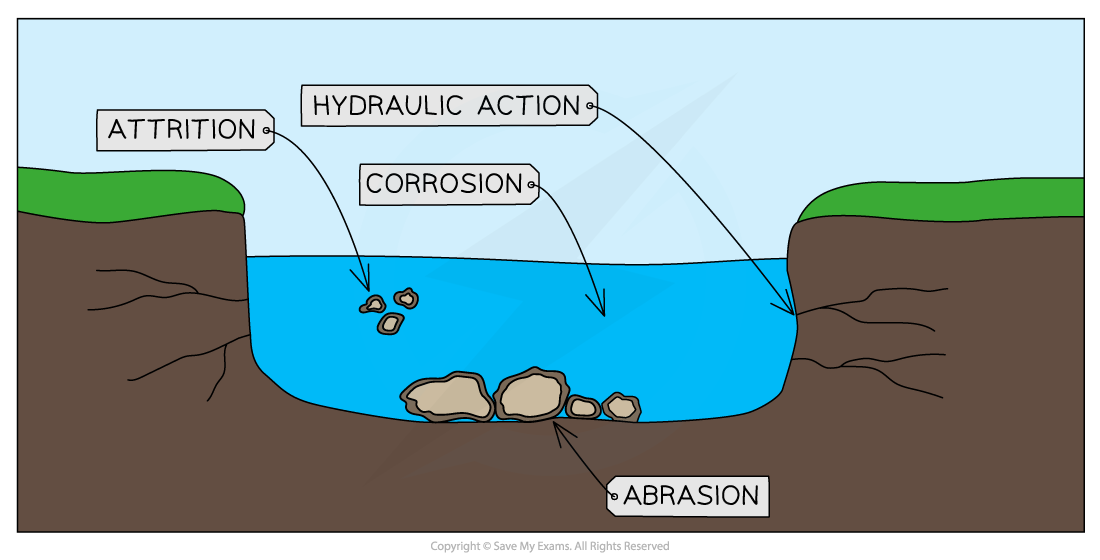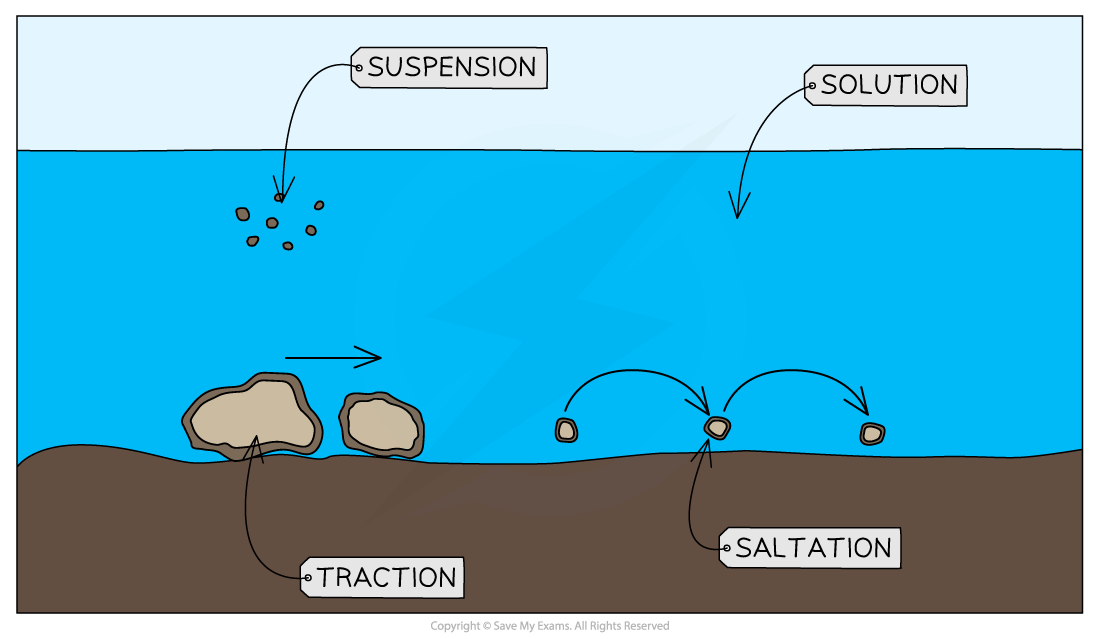- 翰林提供学术活动、国际课程、科研项目一站式留学背景提升服务!
- 400 888 0080
Edexcel IGCSE Geography 复习笔记 1.2.1 Fluvial Processes
Edexcel IGCSE Geography 复习笔记 1.2.1 Fluvial Processes
Weathering & Mass Movement
River valley processes
- Both fluvial and landscape processes shape the river and surrounding land in the drainage basin
- The landscape processes of weathering and mass movement shape land surrounding the river channel
- Fluvial processes shape the river channels and the landforms linked to them. They include:
- Erosion
- Transportation
- Deposition
- Most (about 95%) of a river's energy is used in overcoming friction
- There is more friction in the upper course of the river where it is shallow and narrow
- The rest of the energy is used in erosion and transportation
- Energy in the river depends on the river discharge and velocity
Weathering and mass movement
- There are three types of weathering. These happen in-situ:
- Physical - rock is broken down into smaller pieces. This occurs due to changes in temperature - such as freeze thaw and exfoliation
- Chemical - rocks disintegrate and dissolve in slightly acidic rainwater
- Biological - rocks are broken apart by the roots of plants
- There are a number of types of mass movement where large scale movement of material occurs
- In river valleys there are two main types of mass movement:
- Slumping - where the slope is eroded by the river. This undercuts the slope causing large scale movement of material down the slope
- Soil creep - the influence of gravity causes weathered material to slowly move down the slope towards the river
Factors affecting weathering and mass movement
| Factor | Effect |
| Climate | In hot, wet climates, chemical and biological weathering are dominant |
| Weather | Heavy rain increases mass movement |
| Slope | Any slope over 5o experiences mass movement. The steeper the slope, the more mass movement there will be |
| Geology | Different rocks have different levels of resistance to weathering |
| Altitude | At higher altitudes, freeze-thaw weathering occurs frequently due to the low temperatures |
| Aspect | Physical weathering is more common on a colder, north facing slope due to a higher likelihood of freeze-thaw |
| Vegetation | Roots bind the soil together which limits mass movement |
Worked Example
Explain two factors which influence mass movement (4)
- Identify the command word
- The command word is 'explain'
- The focus of the question is 'mass movement'
- You can select any two factors from climate/weather, geology, vegetation, slope, altitude or aspect
- For the second mark for each factor you must explain why it increases or decreases mass movement
Answer
-
- All slopes which have a gradient of more than 5o experience mass movement (1). The steeper the slope, the more mass movement (1)
- Where rock types are less resistant to weathering (1), there will be more mass movement as there will be more loose material (1)
- Vegetation decreases the amount of mass movement (1) as the roots bind the soil together holding the slope in place (1)
- On the north facing slopes there will be more physical weathering (1) leading to more mass movement as there will be more loose material (1)
- At higher altitudes freeze-thaw weathering may be more common (1) leading to more mass movement as there will be more loose material (1)
Exam Tip
Students often confuse weathering and erosion. Remember, weathering is the physical, biological or chemical breakdown of the rock where it is located - 'in-situ'. Erosion is the wearing away and movement of the material, usually by wind, water or ice.
The Process of Erosion
- Erosion is the wearing away of surfaces
- There are four erosion processes which change the shape of the river channel:
- Hydraulic action
- Abrasion
- Attrition
- Corrosion (solution)

Types of erosion
- Erosion can be mainly vertical or lateral:
- Vertical erosion is dominant in the upper course of rivers. It increases the depth of the river and valley, as the river erodes downwards
- Lateral erosion is dominant in the middle and lower course of rivers. It increases the width of the river and valley as it erodes sideways
Processes of Transportation & Deposition
- There are four processes of transportation:
- Traction
- Saltation
- Suspension
- Solution

Processes of Transportation
Deposition
- When a river does not have enough energy to carry materials it drops them. This is deposition
- The causes of reduced energy include:
- Reduced discharge due to a lack of precipitation or abstraction upstream
- Decreased gradient
- Slower flow on the inside of a river bend
- When the river enters a sea/ocean or lake
- The heaviest material is deposited first, this is known as the bedload
- The lighter materials, gravel, sand and silt are known as alluvium and they are carried further downstream
- The dissolved materials are carried out to sea
Exam Tip
It can sometimes help to remember a word and the process it refers to if you know what the word means.
Traction - the action of pulling something over a surface
Saltation - leaping or jumping
Factors Affecting Processes
| Factors | Impact on Processes |
| Climate | Heavy rainfall and/or low temperatures leads to higher discharge which increases erosion and transportation; below average rainfall and/or high temperatures lead to lower discharge and decreased erosion and transportation |
| Slope | Rivers on a steep slope will be fast flowing and there will be increased erosion; gentle slopes will result in more deposition |
| Geology | Softer, less resistant rocks erode more rapidly than harder, more resistant rocks |
| Altitude | Melting snow and ice increase discharge and therefore erosion and transportation |
| Aspect | South facing slopes have higher rates of evaporation and transpiration which decreases discharge |
转载自savemyexams

最新发布
© 2025. All Rights Reserved. 沪ICP备2023009024号-1









